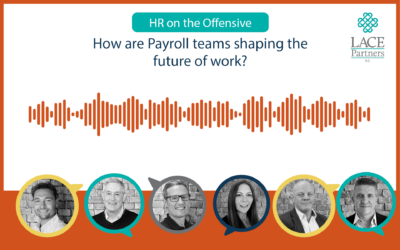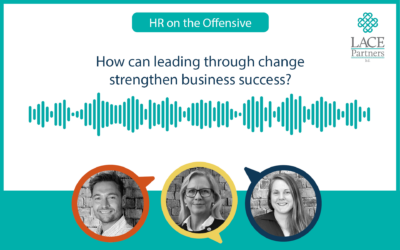In some businesses employees are slowly heading back to ‘the office’ – but what has changed and what will never be the same again? Is this the end of hot desking? Will businesses need as much space?
Aaron and Chris from LACE spoke to Carissa Kilgour from Co.lab Workplace Advisory on this very topic on The HR on the Offensive podcast earlier this year. Find out what you missed below, and stay up to date with our latest podcasts by subscribing here.
Tell us a bit about yourself as the founder of Co.lab and why we’ve invited you to speak to us about the future of the office?
Co.lab is a consultancy that works with organisations thinking about their offices, and how their offices enable their businesses to do whatever their objectives are. Prior to this crisis there was an emphasis on how you can use an office to create a community, how to use your office to increase collaboration, share knowledge and bring people together. Across the world many offices are fitted out in clever ways, shared ways, as we’ve seen the rise in co-working. The way we were working prior to this crisis was a complete alternative to what we have right now and what we are seeing.
My job as an advisor on how to choose and use office headquarters will be turned on its head for a period of time while we experience what changes we need to make in the work environment and see how we can create workspaces which are more adaptable to unforeseen events in the future.
Offices are having to think for the first time about how they separate people, rather than bring them closer together, due to the global pandemic. What messages are you hearing from clients as we exit lockdown?
Everyone’s challenge now is to ask themselves the question: “how much space do we need?”. To contextualise, prior to Covid 19 and following on from the global financial crisis, there were two main drivers of change in how we use our workspaces:
Cost and margin management
Businesses used to take 10% more space than they needed for growth. Each person was sitting in one space, with a fixed computer, a fixed phone and every single day they went to that desk. As we have changed the way we work and adopted new technology and tools, we haven’t needed to sit at a single desk in one location. Businesses started looking at their workplaces and seeing that they had 20-30% excess space, with some real estate directors saying they only saw their workspaces being utilised 60% of the time. That is a huge amount of excess cost. As a result, over the last 10 years we have seen a massive reduction – what’s been deemed the ‘right sizing’ of the workplace – getting rid of any spare capacity.
Capturing innovation
This is about trying to create opportunities for new ideas to be considered and shared. It is about serendipitous interactions in the workspace. A lot of different businesses were thinking about how they could design their spaces in a way to increase the likelihood that you would meet somebody you don’t know, talk about something you are doing, coming up with new ideas along the way.
Steve Jobs, at one point, wanted to design their new Apple headquarters as one big infinity loop with only one set of toilets in the whole building. He knew that every single person would need to use the bathroom at some point during the day and it would cause people to congregate in the same space. The Bloomberg building is another example; it sends everybody up to the top floor and then you need to take the stairs or another lift to get to your floor, funneling people past one other. The idea was that if I am walking past somebody, I might see them and remember a time we had an interesting chat – and that might spark something creative.
These two elements mean that there is now not a huge amount of capacity for most workplaces to come back and be socially distant. There is also the problem of this big drive for creativity and community in the workplace, which the space has been designed around. With those two pieces of context, what my clients are worried about is; do we have the right amount of space and are we going to be able to use it in the way we envisioned, in a safe way?
How are we going to get people into big offices, like those in Canary Wharf where you can only have four people in a lift that would usually take 20?
I think this presents a really good opportunity for businesses to question themselves about why they have an office. That sounds a bit existential, as there are other priorities and human needs in terms of coming in and being together. However, organisations are examining what their driver is for having this physical space. Despite the movements to more agile working I still had many clients – some for compliance and risk management reasons, and some for more cultural reasons – saying that there was no way their teams could work from home.
I recently worked with a financial services business with a very traditional set-up, with fixed desks and the perception that if I can’t see you, you’re not working. We evaluated how much space they would need and they went for 30% more space per person than the average London office worker- which is a real commitment to what they were doing. In light of Covid, they have now reduced their space by more than 40% because they have realised they can work from another location and they can manage their teams from another location.
There are some serious challenges with how you can bring an office back to life, and how you can bring these skyscrapers back to life. When we look at the challenges of going back to work and the space that we will need to maintain safety and respect our colleagues, we need to figure out why we are going there. Are we going there because there are resources that we can’t get elsewhere? Are we going there because we can’t work at home? There will be a lot of younger workers, graduates for instance, who won’t have a decent work from home space. So, we need to consider why we have an office and who we want to bring back and when.
How can you maintain a culture of creativity if people are not going to come together?
The question you need to ask yourself as a business leader is; can we add value without being physically together? What I have heard is ‘probably not to the same extent’. Which means you have to implement something in the interim that gives people a sense of connection, a sense of involvement and a voice. For as long as we need to maintain these distances, these one-way routes around the offices and queuing for the lifts, you are extending your work day way beyond what you would normally be there to do.
Is the recovery of co-working spaces like the WeWork model going to be a challenge now?
Even with what we know about this crisis and how the virus transmits, it still poses the question: does it change our human desire to be in a buzzy space? We might be nervous, but does the need go away? Do we want to be in a diverse group of people in a shared canteen, sitting at a communal table? I know I do, and that I want to be with other people.
I think we understand the risk and people are very worried, so it presents a big challenge for these business models designed around shared spaces. From what I’ve seen so far, these businesses are taking it very seriously and publicly detailing their operating procedures and cleaning regiments. The operators of shared spaces will be better resourced and more capable than lots of individual businesses at creating cleaner, safer, tested and well managed responses to this. I hope that the scale of these operators gives them better capability than my business or your business would have.
What does the office of the future look like in 12 months?
I don’t like to make predictions, because we know that it’ll be wrong! Here are some hybrid predictions/hopes. What I hope is that people will be more trusted to work in the way that is appropriate for them. This experience will give people a lot more evidence that they either can or cannot work effectively away from the office. We can now better trust our employees when we ask our employees about that.
We can be more human. We’ve had to be pretty raw with our colleagues and customers because we are all trying to make it through and figure it out. We’ve seen inside their homes, and although it shouldn’t take away the professionalism we bring to work, hopefully it will increase our empathy and we can be kinder to one another in how we estimate what work we should be doing.
If we have evidence that people can work from various locations effectively and we know we will have to physically and socially distance when we are in the office, I struggle to see why people will want to make an hour’s long commute on a crowded train and come in so they can sit independently from their colleagues. I hope desperately that people don’t re-design their offices to be the isolated cubicles of the past and that they find a way to create a community in a safe way.






